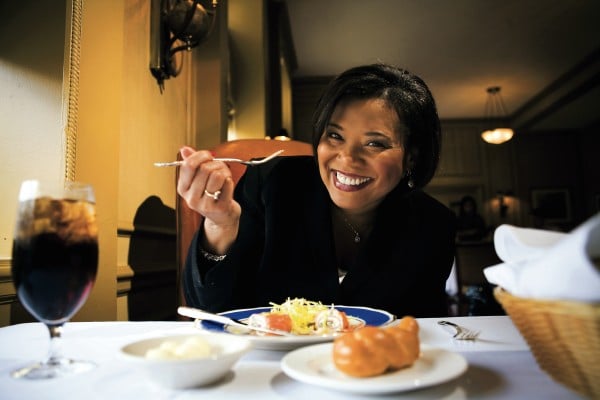Where to Get People to Talk
If reporters are heading to parking garages late at night, it’s usually to get their cars. Deep Throat aside, most meetings with sources are over lunch, dinner, or a latte.
ABC News senior political reporter Rick Klein chats up sources at Union Station restaurants. “Most Washington residents wouldn’t consider eating there,” says Klein, “so it’s easy to blend in if that’s what you’re going for.”
Mark Leibovich of the New York Times, known for insight and humor in his political coverage, often meets sources at the Pennsylvania Avenue Starbucks on Capitol Hill, Woodley Park’s Open City, and Toledo Lounge or Dan’s Café in Adams Morgan.
The Washington Post’s Al Kamen stays “in the loop”—the name of his column—by taking sources to breakfast at Jack’s Fresh on 18th Street in downtown DC. “Spectacular, heart-stopping cholesterol—food by the pound and cheap,” he says. “No one will ever say they saw you, because no one wants to admit they were also there.” He says he sometimes just threatens to take a source there, “and they’ll tell you anything you want to know right on the phone.”
NBC political director Chuck Todd has settled on the Starbucks in DC’s Glover Park as a good halfway point between the NBC bureau on Nebraska Avenue and his sources: “Plus I never worry about running into others there.” He also likes the Daily Grill in Georgetown because of its large menu, which can accommodate “a liberal vegetarian or a conservative red-meat lover.”
Channel 7’s Beverly Kirk likes taking her sources to lunch at DC’s University Club. “It’s really convenient for anyone downtown,” says Kirk. “And people who haven’t been there love it.”
Washington Post military correspondent Tom Ricks isn’t about to reveal where he takes sources to unearth military secrets, but for “thank-you lunches,” such as those with soldiers who have helped him in Iraq, he favors DC Coast or Georgia Brown’s: “At the other extreme, I once took an Army general to lunch at Juanita’s, an empanada joint in Wheaton where English is definitely a second language.”
Politico’s Mike Allen wines and dines his sources on the terrace of Brasserie Les Halles, in the back corner of Bombay Club, on the deck of Morton’s steakhouse on Connecticut Avenue, on the porch at Martin’s Tavern, or in the bar at Bobby Van’s Steakhouse.
You might find WAMU’s Kojo Nnamdi getting the scoop at B. Smith’s at Union Station or Takoma Station Tavern in DC.
Paul Bedard, who writes Washington Whispers for U.S. News, favors DC classics—such as Clyde’s, Butterfield 9, and Charlie Palmer Steak for men and Sonoma, Taberna del Alabardero, and the Hay-Adams for women. All of these might add up to a pricey expense report, but he says, “Nobody drinks anymore, so that helps to keep the tab down.”
—Patrick W. Gavin
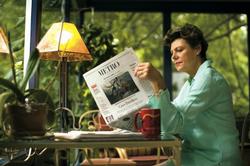
Photograph by Jay Clendenin
Good Morning Reads
Journalists are among the most discerning consumers of news. So what do they turn to with their morning coffee?
Before he dives into the Washington Post’s A section, Bloomberg News executive editor Al Hunt heads to the sports pages, looking for columnist Michael Wilbon. After that, he seeks out stories by political reporter Dan Balz.
Newsweek’s Eleanor Clift starts her day scanning the Post and New York Times front pages and the Post’s Style section. She looks for Times columnist Gail Collins and checks to see who’s on C-Span. But she calls National Public Radio her “mainstay,” listening as she runs in Rock Creek Park.
Houston Chronicle White House correspondent Julie Mason turns to page two of the Post for Dana Milbank’s Washington Sketch. But only after she checks her horoscope (she’s a Sagittarius) and then President Bush’s (Cancer).
Time.com Washington editor Ana Marie Cox, former Wonkette blogger, begins her day by skimming Web feeds from the papers and blogs on her Treo. When she gets her paper copy of the Post, she turns to the comics to read Get Fuzzy.
Fortune’s Nina Easton looks for Milbank in the Post as well as Mark Leibovich in the New York Times. But if there’s an article by foreign correspondent Barry Bearak in the Times Sunday magazine, “that’s a good morning.”
NPR news analyst Cokie Roberts wakes up to NPR—natch—and listens throughout the morning. She starts the Post with the Metro section—first the weather and obituaries—then turns to Style’s Reliable Source, Doonesbury, Ask Amy, and, on Wednesdays, Tell Me About It and Miss Manners.
Politico feature writer Helena Andrews says she’s “not the regular Washington wonky reader.” Her first stop is Entertainment Weekly’s online News & Notes. From there, it’s GoFugYourself.com, a celebrity-skewering blog that Andrews calls “quite possibly the most awesomely bitchy and brilliant blog in the history of the world.” It puts her in the right frame of mind, she says, to write about pols.
If it’s Sunday, New York Times political reporter Jeff Zeleny heads first to Tom Sietsema’s restaurant review in the Post Magazine.
New York Times diplomatic correspondent Helene Cooper is the rare journalist who says she doesn’t look for bylines—“except my own, but that’s for a psychiatrist to figure out why.”
—Jonathan E. Kaplan
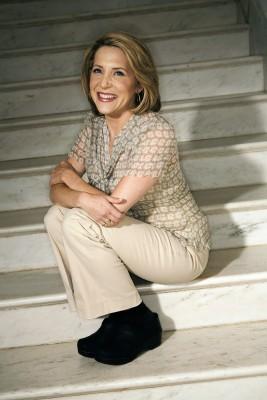
Photograph by Jay Clendenin
These Shoes Are Made for Stalking
Days spent chasing lawmakers on the Capitol’s marble floors can be a challenge, especially for women. The hard marble puts pressure on knees and backs and even makes for slips. What’s the footwear of choice for congressional correspondents?
“Rubber soles are a must,” says Anne Kornblut, who often tracks the movements of Senator Hillary Rodham Clinton (who wears low heels) for the Washington Post. Kornblut says she’s found a shoe-repair shop that will add rubber soles to her leather shoes.
NPR’s Andrea Seabrook hasn’t worn heels since the day before President Reagan’s funeral, when Kentucky governor Ernie Fletcher’s airplane violated DC airspace, forcing an evacuation of the Capitol: “That one moment—seeing the very real fright in the cops’ eyes and one lady’s high-heel shoe lying on its side on the marble floor as I tried to get outside—was enough to keep me in flat soles for the rest of my Capitol career,” Seabrook says. Now she wears black leather flats or sandals.
Ana Marie Cox, DC editor of Time.com, also decided to stick with flats after having her shoes’ small kitten heels sink into the ground outside the Capitol during an interview, forcing her to stand on a box.
CNN congressional correspondent Jessica Yellin prefers clogs because they’re good for posture and are more attractive than many other ergonomically friendly shoes. Lynn Sweet of the Chicago Sun-Times favors Dansko’s comfy shoes.
Juliet Eilperin, a onetime congressional reporter for the Post who now writes about the environment, says former majority leader Dick Armey, a Texas Republican, taught her that cowboy boots are best for pounding the marble floors.
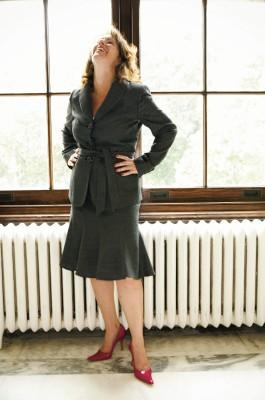
Photograph by Jay Clendenin
A shoe addict, Susan Milligan of the Boston Globe toughs it out wearing flashy stilettos. She admits they “kill” her back, but they also get her noticed. One Massachusetts Democrat routinely comments on her shoes.
Another correspondent who sacrifices comfort for style is five-foot-one Jill Zuckman of the Chicago Tribune, who wears heels for the height.
But former Congressional Quarterly writer Gebe Martinez says it’s “no Manolo Blahnik heels for me.” After two foot surgeries that she says were due largely to long hours at the Capitol, the freelance Hill reporter gave up fashion for “ugly, clunky shoes or flats along the lines worn by Ted Kennedy.”
Having pounded the marble for five years, I can attest that few men wear anything but oxfords or loafers. Occasionally, some television reporters wear sneakers. Jeff Zeleny of the New York Times, one of the snazzier dressers on the Hill, swears by Cole Haan black oxfords. He says their rubber-sole padding is kind to his feet, knees, and back.
—Jonathan E. Kaplan

Illustration by Francisco Caceres
Mostly True Confessions
Sure, they may hunker down with the latest book on Iraq after a hard day’s work, but journalists also indulge in their share of guilty pleasures, many involving junk food, TV, or both.
Time’s Karen Tumulty is a fan of cable’s E! True Hollywood Story. Her husband, Paul Richter, who covers the State Department for the Los Angeles Times, will watch anything on the Tennis Channel, including reruns of matches from the 1980s and Ping-Pong tournaments.
The online Cook Political Report’s Charles Cook admits to watching The Jerry Springer Show. And American Urban Radio’s April Ryan says she’s been a reality-show junkie since the early years of the Bush administration, when she got hooked on MTV’s The Real World: “White House press secretary Ari Fleischer and I would talk about the shows after each episode.”
CNN’s Ed Henry likes nothing more than watching HBO’s Entourage or Curb Your Enthusiasm with a big bowl of ice cream. The Wall Street Journal’s John Harwood admits that his twin passions are chocolate-chip ice cream at Moorenko’s Ice Cream Cafe in Silver Spring and watching American Idol with his daughters.
Washington Post Style writer Libby Copeland says she’s “one of those Law & Order junkies.” She watches reruns on TBS and TNT: “They go right from the credits to the opening of the next episode. It’s so cruel.”
The Atlantic’s Joshua Green is a fan of MTV’s Jackass, and National Review’s Jonah Goldberg likes such science-fiction shows as Star Trek, Buffy the Vampire Slayer, Angel, and Firefly.
CBS’s Steve Chaggaris confesses a love of 1970s disaster movies: “There’s nothing better than kicking back on the couch with a Löwenbräu and watching The Towering Inferno or Beyond the Poseidon Adventure.”
MSNBC’s David Shuster and his wife, Bloomberg’s Julianna Goldman, are such Grey’s Anatomy fans that they schedule their Thursday evenings around the ABC show and buy each episode on iTunes for a second viewing.
Not everyone looks to TV for secret pleasures. Associated Press reporter Nedra Pickler is “an eBay and Craigslist junkie.” She has sold everything from dying houseplants to a package of long underwear. For Mark Segraves of WTOP, the day isn’t complete without a nightly Coke float—or two.
Washington Post managing editor Phil Bennett says that “it may cause family embarrassment,” but he’s ready to declare that he’s a Shakira fan: “I think she’s awesome.” Bennett was introduced to the Colombian pop singer when he was in Shakira’s native country: “I think most people are just surprised that someone in a stuffed-shirt position would even know who she is.”
Legendary White House correspondent Helen Thomas says she “can’t confess to a single bad habit or guilt.” Instead, she encourages her fellow journalists to “eat, drink, and be happy.”
—Patrick W. Gavin
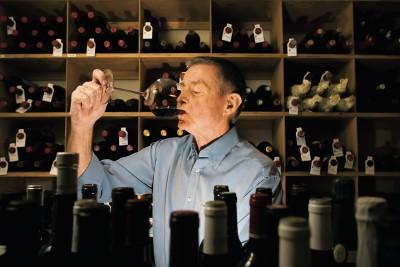
Photograph by Jay Clendenin
After Deadline
They may not transform themselves as dramatically as Clark Kent, but many Washington journalists have alter egos, pursuing hobbies and passions far outside their line of work.
New York Times congressional reporter Carl Hulse may look like a city slicker, but he rides rodeo. Hulse’s screen saver at work is a picture of him on his mount, rustling up dust back home in Illinois, where he learned to ride.
As the Washington Post’s Robin Wright covered wars and uprisings around the world, she also picked up the game of chess: “It concentrates the mind on something besides the boom-boom outside. And you can take it anywhere—bunkers, bomb shelters, and basements.”
Wright started collecting chess sets and then began playing for the set in shops around the world: If she won, it was hers for free; if not, she paid. Wright’s Georgetown home is now decorated with sets from Tehran, Beirut, Cairo, Damascus, Moscow, Hanoi, Johannesburg, and Entebbe.
CBS’s Bill Plante started drinking wine in college for one reason: He didn’t like beer. (He’s since come around.) That led to his first trip to California’s Napa Valley in 1966 and his first visit to France’s vineyards in 1970. Now Plante has a 1,500-plus-bottle collection in the basement of his Georgetown home. He acts as sommelier for the press corps on presidential trips. “I love good, mature Bordeaux more than anything else,” he says.
NPR’s Cokie Roberts needlepoints mainly to create gifts for her children and grandchildren. But she has another use for the hobby—to survive long meetings or, even better, conference calls. Says Roberts: “The other people on the line can’t see you.”
Ed Chen, Bloomberg’s White House correspondent, runs more than 30 miles a week. Chen and his wife, Meredith, bike most weekends from Bethesda to Georgetown on their tandem.
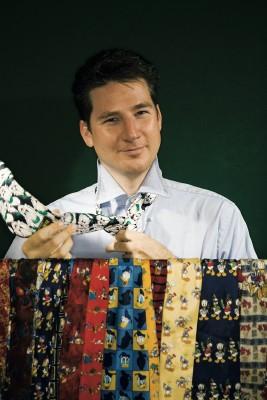
Photograph by Jay Clendenin
Political reporter Stephen Dinan is an exception to the Washington tendency toward bland business attire. The Washington Times reporter almost always sports one of his 23 ties featuring Donald Duck.
CNN’s John Roberts fell in love with motorcycles as a kid—he tried making one by attaching a lawn-mower engine to his bicycle. It worked. Years later, Roberts is the proud owner of two Harley-Davidsons.
Post Style reporter Sridhar Pappu grew up in southwestern Ohio, so it’s no surprise he’s a Cincinnati Reds fan. Pappu has set out to collect all of the Reds baseball-card sets from 1969 to the present, and he’s halfway to his goal.
Newsweek’s Holly Bailey is such a karaoke devotee that she has scouted out the best karaoke spots in New Hampshire and Iowa, where the political reporter is spending a lot of time.
Fox News’s James Rosen owns nearly 2,000 Beatles CDs. He says: “The day when there are no Beatles left alive is an unbreathable nuclear winter to me.” In March, he and his wife, Sara Durkin, welcomed Aaron Lennon Rosen into the world.
Politico’s Jeanne Cummings spends hours in her garden to take her mind off politics: “You know you’ve had a good yard day when you blow your nose and peat moss comes out.”
Tom DeFrank of the New York Daily News says he’s “a fanatic” about Chip Hilton sports books—the originals by Clair Bee. He’s scoured the world for the 1950s books and has all but the last two.
—Patrick W. Gavin

Illustration by Francisco Caceres
Poker Faces: You In or Out?
Every three weeks or so, a handful of political reporters heads to the Capitol Hill home of the New Republic’s Tom Edsall for a poker game. Players include Jim VandeHei and John Bresnahan of Politico, Chuck Todd of NBC, Michael Shear and Peter Baker of the Washington Post, Mark Mazzetti of the New York Times, Neil King and Christopher Cooper of the Wall Street Journal, Michael Scherer of Salon.com, and David Plotz of Slate.com.
“There is a lot of wise-guy stuff and a fair amount of beer drinking,” says Edsall, who provides sandwiches. “I make a lot of nasty jokes. We question each other’s manhood.”
Edsall is a frequent winner, but VandeHei holds the record for biggest single-night win: $900. During the game, Edsall cuts the pot to make back the cost of the food. “I’m always accused of cutting the pot in order to make a profit,” he says.
Edsall started out in another poker group, a weekly game that has been going on for nearly 30 years and includes veteran political writer Jack Germond, the Post’s Bob Woodward, retired Post editor Peter Silberman, and retired Time political reporter Laurence Barrett. Through the years, it has evolved into a close-knit group of men—now as many lawyers as journalists—who rotate homes, play for pretty high stakes, don’t talk much politics, and try to keep the details of their get-togethers quiet.
A source close to one of the players leaked a few tidbits: They used to do a lot of smoking; now anyone who wants to smoke has to go outside. Most of them have switched to decaf coffee. They start and end earlier than they used to. One thing hasn’t changed, according to the source: “Serious is not allowed.”
—Patrick W. Gavin
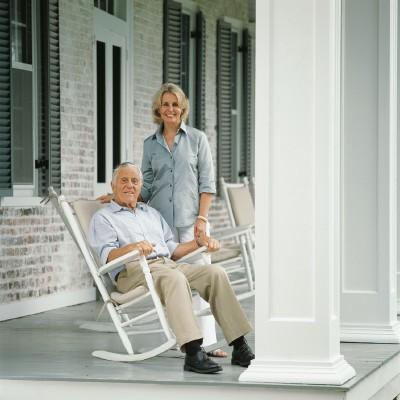
Photograph by Erik Kvalsvik
Getting Away From the Big City
Many Washington journalists have done well enough to afford second homes.
Bloomberg’s Al Hunt and his wife, PBS correspondent Judy Woodruff, have a home on a creek in Maryland’s Calvert County, about an hour’s drive from DC.
The Washington Post’s Bob Woodward and his wife, New Yorker writer Elsa Walsh, have a second home with a pool house in Edgewater, Maryland.
Former Post executive editor Ben Bradlee and his wife, Sally Quinn, now a religion blogger, restored a 1740s estate on the St. Mary’s River in southern Maryland for their country retreat. But August often finds them at their East Hampton mansion on Long Island. Former Nightline anchor Ted Koppel—now an NPR senior news analyst—also heads to the banks of the St. Mary’s River.
Matthew Cooper of Condé Nast Portfolio and his wife, Mandy Grunwald, longtime adviser to the Clintons, spend time at a cottage on Martha’s Vineyard. Another Vineyard homeowner is John Donvan of ABC News.
John Dickerson, Slate.com’s chief political correspondent, spends August at his home in Castine, Maine.
—Jonathan E. Kaplan

